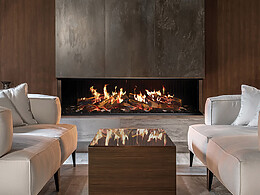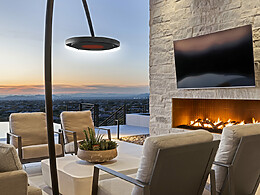
The gorgeous works from Valley artist Niki Woehler have graced the walls of Found:Re Phoenix Hotel, in galleries across the nation and on the walls in luxurious homes locally and beyond. From commissioning a work of art to taking care of and lighting said masterpiece, Woehler gives her professional guidance regarding art within the home.
>This is one time where size really does matter, and bigger is better. There’s little less aesthetically satisfying than a piece of art that’s too small for a space. The general rule of thumb is to choose art that will take up two-thirds to three-quarters of the wall. You should also consider the orientation of the space and mirroring that with your art. For example, a tall narrow wall should generally have a taller, portrait-oriented piece, while a longer horizontal wall should have a landscape-oriented painting. However, as with just about everything, there are always exceptions: you can use multiple panels or pieces assembled to create the same orientation and fill the space appropriately.
>Consider commissioned artwork any time, but especially if you just haven’t found something that speaks to you or has the correct size/proportions or even color palette that achieves the desired feeling of your space. And there’s an element to commissioning a piece of art that might be even more beautiful: you will forever have an even deeper connection to the art and the artist because you worked together, shared stories, laughs and often a glass of wine on the day you hang the art together.
>While you may love something in a gallery or online, until you see it where you want it to hang, it’s natural to be concerned that it might not work once you get it home. If that’s the case, one of the services I offer my clients, interior designers or home owners directly is the ability to hang it and live with it for a day or so before they fully commit. Art can be a sizable investment, both financially and emotionally. I want my work to be a source of love and joy for them every time they see it, so if they would like to test drive it in their space, I’m perfectly OK with that.
>One of the benefits of acrylic paint, which is what I use when I paint, is that it can be wiped down safely with a damp cloth to remove any dust that accumulates. It’s really very simple. And if the piece is in direct sunlight, I usually suggest a quick spray of a sealant with a UV filter (available at Michael’s or any art supply store) every couple of years just to keep the colors fresh and vibrant. When it comes to my resin panels, those are even less demanding. A quick wipe down with a dry cloth always does the trick. And in the unlikely event that somehow they get scratched—because life happens—it’s a simple phone call and I can fix the problem in a day for them.
>Light is one of the most important parts of art and should never be ignored. While generally speaking sunlight is always best, not every room is filled with natural light, so it’s important to choose lighting that brings out the beauty of the art. Lights should be positioned so that it’s illuminated evenly and at the right “temperature.” You want to avoid hot spots and glares. With my resin pieces, I advise my clients to choose bulbs that mimic daylight, so a pure, white light, with no blue undertones, somewhere around 5,000 to 6,500 kelvins. With my canvas art, LED lights in a true white are usually perfectly appropriate to illuminate and bring out the depth and nuances of the work.










